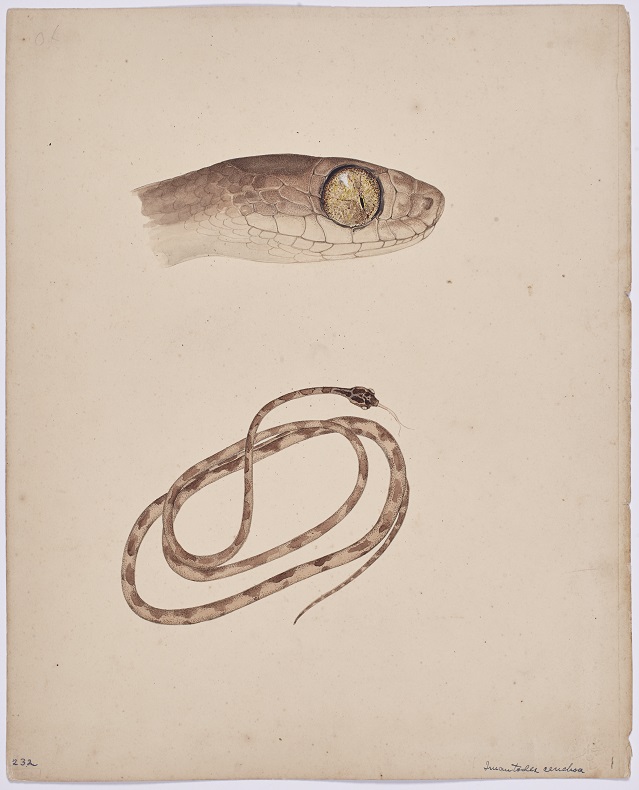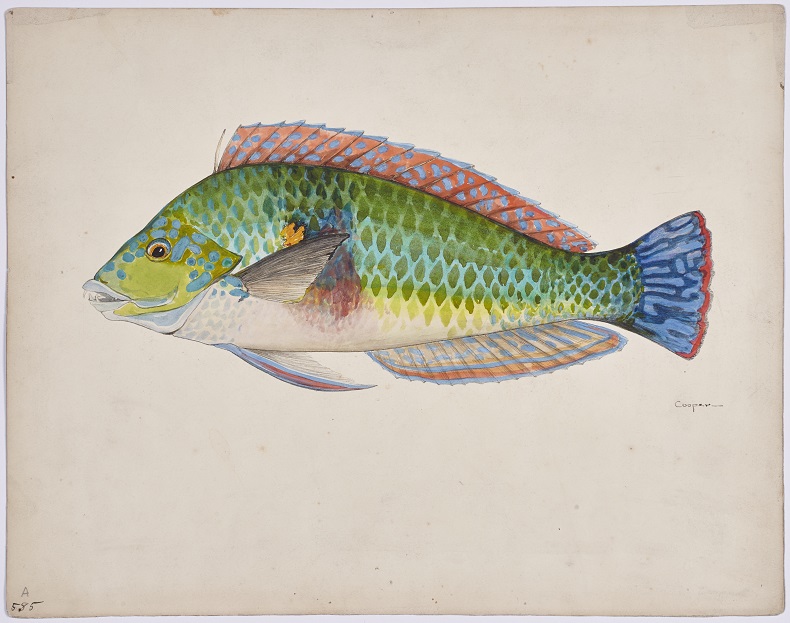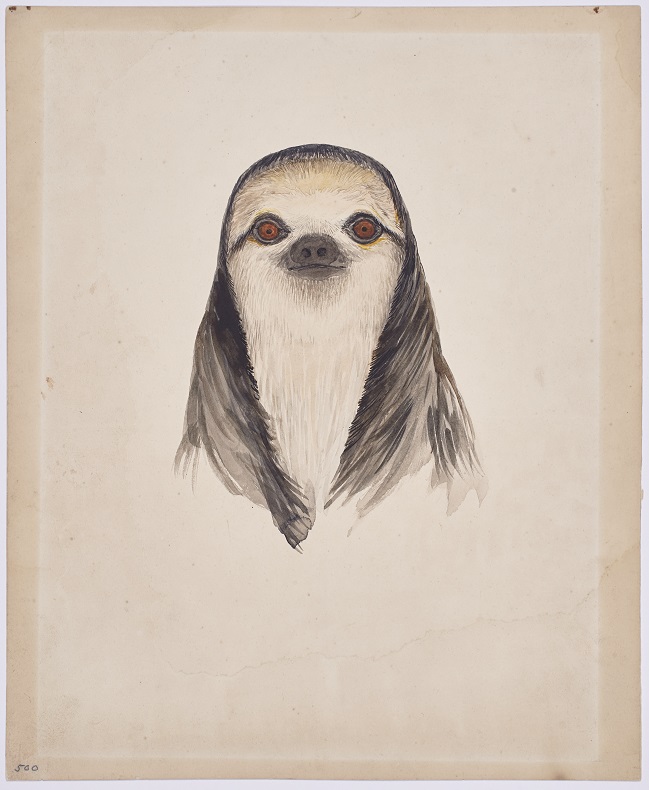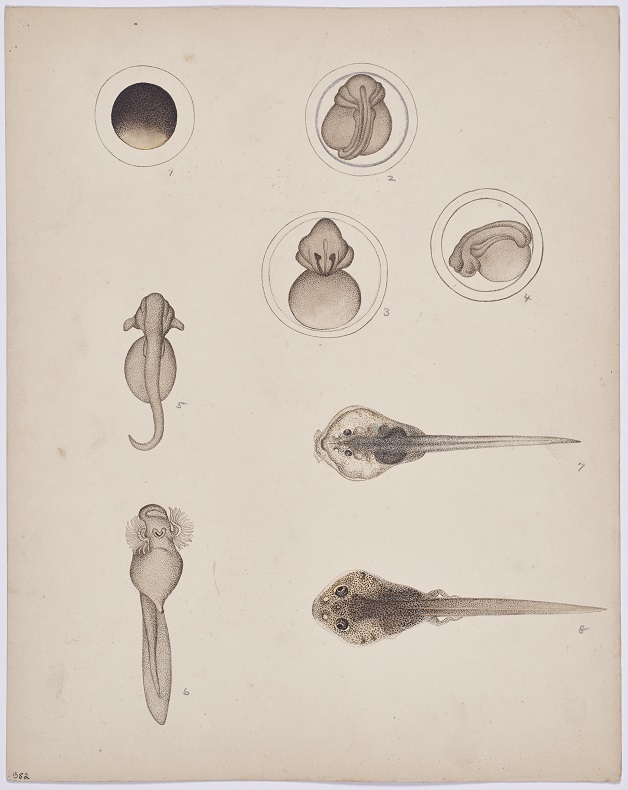
It’s not obvious how to draw a snake. Here, let Isabel Cooper tell you about it, in a 1924 article she wrote for The Atlantic Monthly.
For instance, there’s no such thing as a school of snake artists, so when the problem of making a portrait of a snake presented itself I had to think up the technique for myself. There are many odd little worries connected with this problem, such as the invention of the proper anaesthetic for deadly reptiles, to put them out of the misery of posing and yet allow the colors of life to linger from day to day.
Unlike birds and butterflies, she explained, the snakes and frogs don’t look so nice after you preserve them and put them in a museum collection.
Most remarkable and significant in the appearance of most of these creatures—and soonest extinguished by death—are their eyes. This is especially true of snakes. The instant they pass, a dreadful mildew creeps up over the sparkling black pupil and the decoration of the brilliant iris, until the eye looks like a mouldering moonstone.
In 1920, photography couldn’t touch the glory of these animals. But watercolor could. Cooper painted this snake’s portrait at a field station called Kartabo in British Guiana (now Guyana), established by the explorer William Beebe.
Beebe was a biologist who turned his interest in the tropics into the Department of Tropical Research Field Expeditions, part of the New York Zoological Society (now the Wildlife Conservation Society). He was an ornithologist, explorer, and author of more than 20 books, many for popular audiences. He figured that part of reaching those audiences–and recording the biodiversity of the tropics–was through really good art. So he hired Isabel Cooper and other artists for his expeditions. Those artists’ work lives on in the WCS archives, and recently it was part of an exhibition at The Drawing Center in New York. The show closed on Sunday, so this is an ill-timed blog post, but you can still buy the catalog or read it online.
Cooper went on several of the department’s tropical expeditions, to the forests of Guyana and to the seas, including the Galapagos. In a 1925 letter, she described putting on a diving helmet, “a most enormous lark:”
You feel as foolish as anything under water. After you’ve been down a bit your feet become very light, and you can’t keep them down. They simply waft about in an aimless way, as do the arms of Greek dancers. Also, everything gets distorted. Rock ten feet away looks as if you could touch it. You make a lunge toward it and find yourself flapping around like a jellyfish with an extremely swelled head.

A few years later, after her last expedition, Cooper married Charles D. Mahaffie, the recipient of that letter. They had a kid, and that kid had a whole bunch of kids, and then one of those gave birth to a baby named Joanna Church, who approximately 13 years later became my best friend. And that’s how, on Saturday, I happened to be looking at Isabel Cooper’s art with her great-granddaughter, moaning at how we couldn’t imagine ever being that good at watercolors.
The art is marvelous. Just look at this sloth. Doesn’t it look like it has wisdom to impart?

In that 1924 Atlantic article, Cooper wrote about the risks of painting live specimens, which included the snakes that are inclined to strike at you, the various critters who excel at escape, and also this:
Sometimes an extra spurt of life gets ahead of my merely human fingers, as when a tadpole telescopes his tail and turns into a young frog right before my eyes, or when a caterpillar disappears from view in his cocoon, or a chrysalis goes to work and hatches, while I am taking time off to eat lunch or clean my paintbox.

The science of ecology was still young when Beebe was doing his expeditions. While zoology tends to deal with specimens in isolation, ecologists study how different species relate to each other and their environment. Beebe would do things like collect the leaf litter from four square feet of jungle floor, catalog the critters that lived in it–then write about it, charmingly.
Some academics weren’t so sure that Beebe was a serious scientist. He hired women as both artists and scientists–so strange–and he was famous for his popular writings. Scientists are often a bit snippy about colleagues who put energy into communicating with the public. I will note that his very technical Monograph on the Pheasants, published in 1919, was well received and continues to get good reviews on Amazon. (“To say that it fully meets our most sanguine expectations is but inadequate praise,” wrote a reviewer in The Auk.)
And I’m thankful today that he and his team put so much energy into sharing their experience of the tropics.
Art by Isabel Cooper, courtesy of Wildlife Conservation Society Archives
Thanks to the Drawing Center for setting me up with all of these lovely images; to Joanna’s uncle John Mahaffie for his blog posts and a timeline about Isabel Cooper; and to the curators of the exhibition for their awesome catalog, on which I have relied heavily–especially the excerpt of Isabel Cooper’s 1924 Atlantic article “Wild-Animal Painting in the Jungle.”
One thought on “Wild-Animal Painting in the Jungle”
Comments are closed.